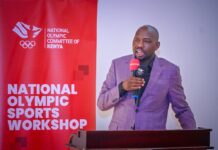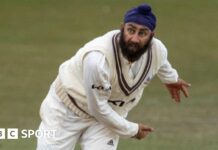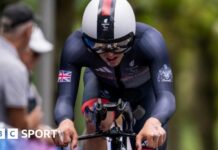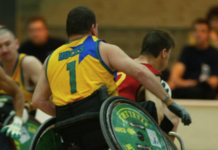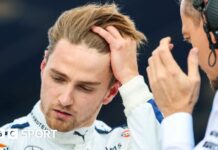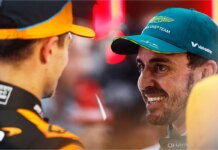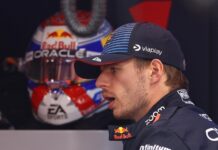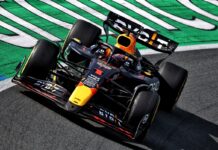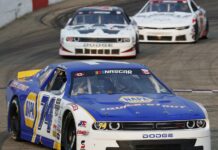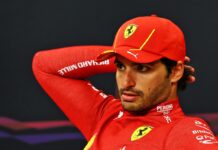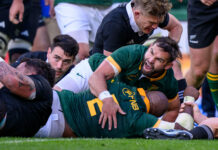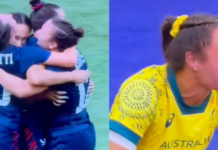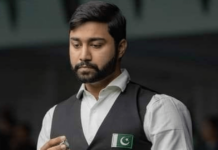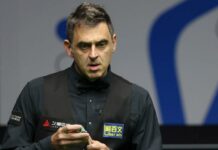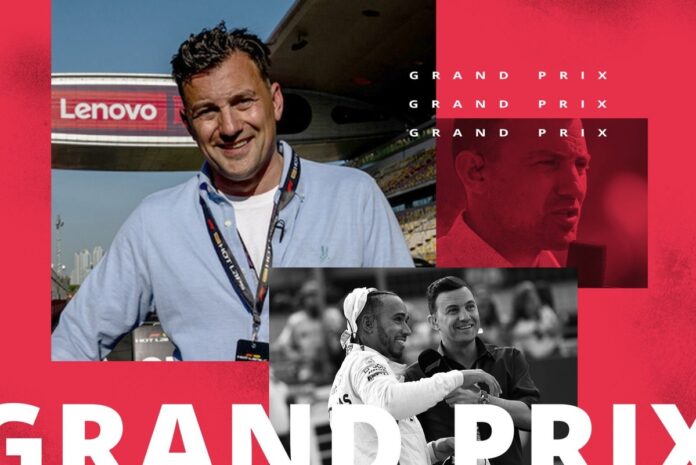It’s the last race of the Formula 1 season before a much-needed summer break, with much of the paddock running on fumes—and yet Will Buxton is his usual animated and energetic self, launching into conversation even before I tap the “record” button. It’s the same energy that’s carried the 43-year-old Brit through a winding career as a journalist, on-air presenter, talking head (and meme fodder) on “Drive to Survive”—and author. Buxton’s back to his first love, writing, with the release of his second book “Grand Prix: An Illustrated History of Formula 1,” a richly detailed and visually stunning tribute to the sport’s illustrious past and vibrant present.
“It was born out of a statistic that Stefano Domenicali [the president and CEO of F1] spoke of last season, which is that one in three viewers of Formula 1 have been watching the sport for five years or less,” says Buxton. “The sport has 1.5 billion viewers in 180 territories, [so] there are 500 million people who’ve been watching for less than five years. Which means they never saw Sebastian Vettel in a competitive car, they never saw Michael Schumacher race… let alone have a real understanding of who was Ayrton Senna, who was Alain Prost, let alone Jim Clark and Juan Manuel Fangio.”
The book then, is meant as a guide to the sport that will help newcomers get their bearings, and catch up on a past that still very much impacts the sport’s present.
“This sport has so many specifics, so many fine details, that when you’re in this bubble, you almost can lose sight of the fact that not everybody knows all these things,” says Buxton. “We live in an era of quite a toxic social media environment. Where you can be a new fan and say: ‘Hey, I’m new to the sport. I love Max Verstappen.’ And people will go: ‘Ah, you’re just a new fan.’ But how do you learn if no one opens their arms and welcomes you?”
“Because we all had our first race. Even Roger Benoit—who’s done 800 plus races; the most experienced, most knowledgeable journalist in the paddock—had a day where he knew nothing. And that’s the purpose of the book. It’s to introduce everything that’s happened in a way that isn’t too scary.”
Over a trackside conversation during a hectic weekend at Spa, Buxton tells me about what he learned while researching “Grand Prix: An Illustrated History of Formula 1”, his pick for the best F1 driver ever, and life as a meme.
The following interview was edited for clarity and length.
What was the hardest part of squeezing almost 80 years of F1 history into a single book?
So, with every champion, you get one beautiful illustration and one page of text. It’s 400 words. It’s a really easy read. I thought the most difficult ones to write would be the drivers that I never experienced: the guys from the ’50s or ’60s or ’70s. But their careers were actually quite short. Either because the sport was very dangerous back then and they were killed—or because their careers naturally just didn’t last so long, because of the rapid development of the sport from the pre-war cars into the development of the 1960s, into the development of aerodynamics. It was changing so fast that a driver who was brilliant in the early 1950s suddenly found himself in a completely different type of car to drive five or six years later.
And then you come to a driver like Fernando Alonso, who’s been doing Formula 1 for twenty years. Let me tell you: trying to condense twenty years into 400 words is a lot harder than trying to condense five years into 400 words. That was the biggest challenge.
On sale August 13th; available now for pre-order
Did you learn any new facts you uncovered for yourself?
A lot of the knowledge that I had was of the drivers and their careers in Formula 1. But in explaining the drivers—what they meant, how they drove—I had to do a lot of research into the method by which they arrived in Formula 1. That, for me, was fascinating—those stories of the different paths that the drivers took, how they made it to Formula 1. Because everybody’s path is unique, particularly when you compare a Giuseppe Farina, a Juan Manuel Fangio, a Mike Hawthorne to a Lewis Hamilton. The paths couldn’t be more different. And so those were the most fascinating aspects for me.
You describe every Formula 1 world champion in the book. If you had to choose the greatest driver of all time, who would it be?
For me, there are two greatest of all times. Not necessarily because of what they achieved in Formula 1, but because of their versatility and what they were able to achieve across different categories. So for me it’s Stirling Moss and Mario Andretti.
Stirling was never a [Formula 1] world champion, but he appears in ‘Grand Prix’ because, for every decade, I have included a driver that didn’t win the world championship but had all the attributes that meant they should or they could have won the world championship. Drivers like Stirling Moss, Dan Gurney, Ronnie Peterson, Gilles Villeneuve… Greats of the sport who never lifted the ultimate crown.
So Stirling, for me, was the best of the best. And Mario as well was a driver who, like Stirling, could get into anything and win straight away. They, for me, were the greatest of all time.
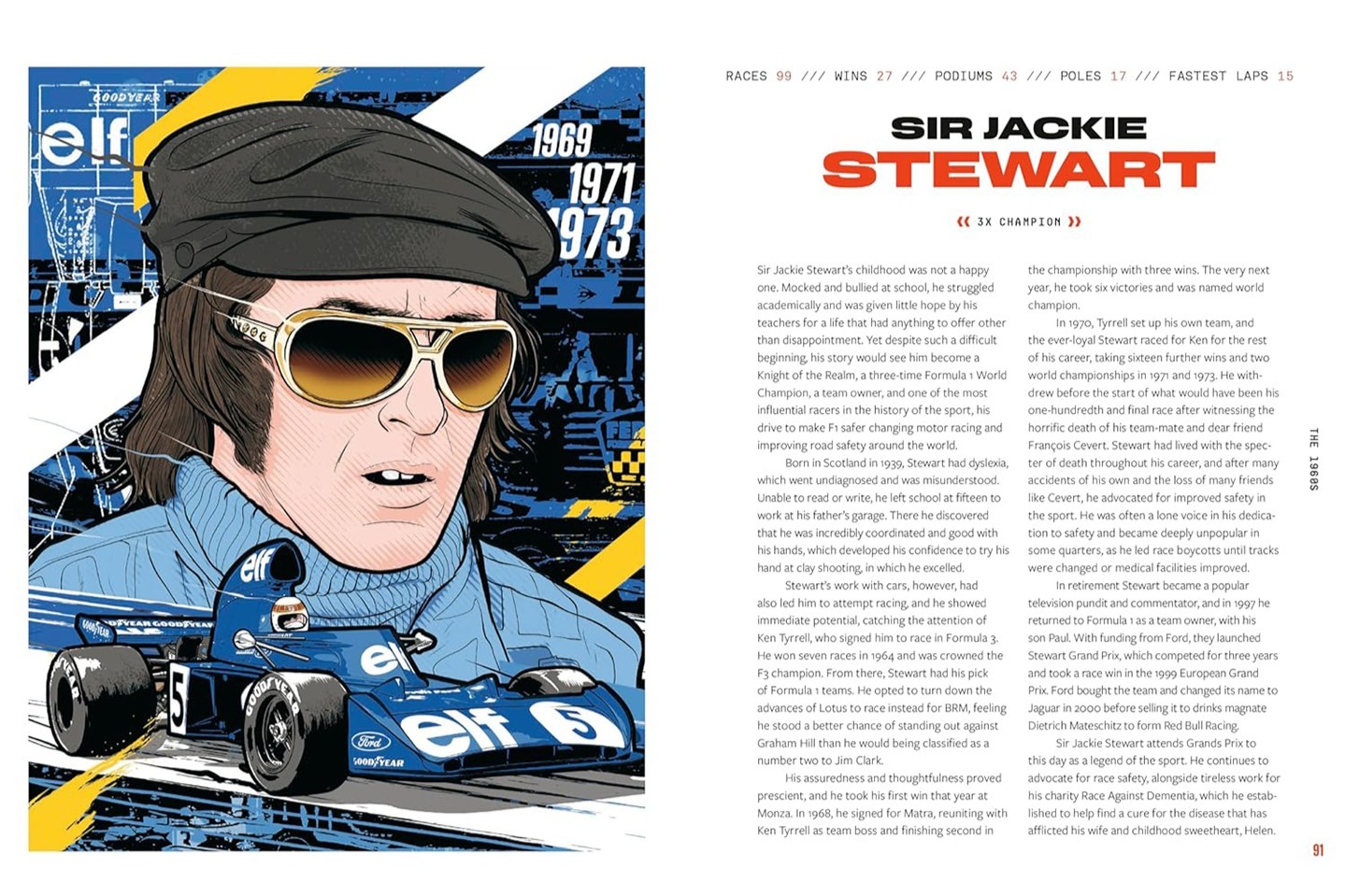
There are 24 races on the F1 calendar, there is pre-season testing, team launches, and all kinds of promotional events. How did you manage to find the time to write ‘Grand Prix’?
I started writing it on my honeymoon! Which my wife was actually absolutely fine with! We were in the Maldives. So she sat in the pool and I spent the morning writing. When you write, you need to take yourself to a place where you’re in your little zone. My zone was staring out into the ocean and writing. And that was lovely. Not how you’re supposed to spend a honeymoon, but that was great.
It took a year from workshopping the concept, to starting the writing, to getting the final script in and signing it off, and sending it off to be printed. From pre-season testing 2023 to pre-season testing 2024. That was a challenge in itself, but a really, really enjoyable one.
“We can’t deal in the gray areas, because that’s simply irresponsible for us.”
Writing a book is a lot of work. It’s not only the writing process but also the multiple rounds of editing can take a lot of time.
What was really funny is, it’s the first time I’ve worked with an American publisher. I remember the first edit I got back, they’d Americanized a lot of words. I said, okay, I’ll let this word slip and I’ll let this word slip. But in a couple of occasions they changed a word to ‘gotten’. And I said, ‘I’m sorry, but there is a line that I’m not prepared to cross—and ‘gotten’ is a line that I’m not prepared to cross.’ So that was fun.
“But honestly, they were amazing and the editing process was amazing. They fact-checked, obviously, everything that I put in there. And when you’re writing, you will slip up, despite how well you know the sport. You’ll make a mistake—like, you put 1982 instead of 1981. And they recognized these things. The fact-checking was superb on it.
So this book is for new fans of F1, first and foremost. When did you become a “new fan”?
I became a new fan when I was six or seven. I didn’t come from a racing family, and my parents weren’t really into racing. My dad and I fell in love with Formula 1 at the same time—I just loved the color and the noise. I didn’t really understand it, I just found it exciting.
As I became a teenager, I started to want to learn more about it through—we’re talking pre-internet age—hard copy magazines like Autosport and Motoring News. They were my bibles. It was the late 80s, early 90s; the Ayrton Senna, Alain Prost era. Nigel Mansell, Nelson Piquet. That was the era when I fell in love with the sport, and when I really started to dive into it and to learn more.
Was it always your goal to work in Formula 1?
From the age of 13, all I wanted to do was write about Formula 1. Senna was my hero. When he was killed, that’s when my dad bought me my first copy of Autosport magazine. The tributes that were being paid to Ayrton Senna by the journalists in the magazine made me gain a level of understanding and acknowledgement and acceptance of his passing. Literally the week that I read those pages, I said: ‘That’s what I want to do.’
Television was just a mistake. All I ever wanted to do was write about Formula 1. Getting back to my first love, which is writing, was a real joy.
You said TV was a mistake. But it seems like it was a beautiful mistake.
Absolutely glorious. I was a writer, but the opportunities weren’t really there. And it was very expensive to be a freelance journalist. It still is today. But going back 25 years, websites were still very young, blogs didn’t exist, YouTube wasn’t a thing. There were very few outlets for you to write.
I got the opportunity to become press officer for the GP2 Series, which is now known as Formula 2, and I worked with the likes of Nico Rosberg and Lewis Hamilton coming through as junior drivers. And then came back to journalism a few years later, and I got a phone call from F1 saying: ‘We need a commentator for GP2. You know everything there is to know about it. Do you want to give it a go?’ I said: ‘Yeah, I’ll give this a go.’ So I did a year of that and at the end of that year I got a phone call from America saying: ‘We need a new F1 pit lane reporter. We’ve heard your commentary on GP2. We love it. Do you want to be our pit lane reporter?’ And I was like, yes, that sounds amazing! And I started doing pit lane reporting for Speed Channel and then for NBC Sports.
So my journey into television was a complete mistake. I grew up with Murray Walker as a commentator. That was Murray’s job. I never had a dream to do that. It has taken me places, given me a career, given me opportunities I never in a million years imagined would come about. And it’s just been a total joy.
What are the biggest differences between working for an independent media and working for Formula 1’s official platform?
I get in trouble a lot more now that I work for the official channel! No, I’m joking! If we were told that we have to wear the F1 shirt with the F1 logo, I think we would be really restricted in what we could or couldn’t say. Because you’d be seen as having the official voice and the official messaging of the sport. That’s not our job. Our role is to tell the stories. If hard questions need to be asked, we’ll ask those hard questions.
We can’t deal in the gray areas, because that’s simply irresponsible for us to do so. Because while we carry the F1 logo and the F1 branding, there will always be a notion that what we say and what we put on air has absolute legitimacy. We obviously have to be very careful in what we say. But I can’t recall a time where I’ve ever been told: you mustn’t say this or you mustn’t say that. It’s just that we must always be completely fair and completely non-partisan in everything that we do.
A large audience knows you from ‘Drive to Survive’. What has it been like for you to see yourself on Netflix?
It’s been an absolute thrill to do it and to play the role that I’ve been able to in the series. I was never expecting or anticipating anything. But when you meet new fans, and they reference the series and talk about what the series has meant to them and how much the sport now means to them, it’s incredible.
I find the recognition thing really, really wild and crazy. And a bit embarrassing. I don’t really see it as a personal recognition—I see it as a recognition of the series and the sport and how much it’s growing. That if they recognise me, they’re not recognising me, they’re recognising the series, because they’ve become a fan of the show and the sport as a result.
In the first seasons of ‘Drive to Survive’ you really had to explain the basics of the sport. It must be a good feeling that you don’t have to explain what qualifying is anymore.
You know what? I still do. And there’s a reason for that. It’s not ‘Game of Thrones’, right? You don’t have to watch season 1 [of ‘Drive to Survive’] to understand season 5 or 6. You can just watch the last season. If you’re new to it, [we] still have to explain those basic things every now and then. Not to the extent that we did in season 1. But if you take for granted a basic level of understanding, if we just assume that everybody knows, you lose them.
What I learned through my time with NBC Sports is, you have to be aware that you will have a viewer who’s been watching the sport for thirty years and a viewer who’s been watching the sport for thirty seconds. You have to walk that tightrope of not blinding the brand-new fan with things that are going to be scary and put them off—but you can’t dumb it down to the extent that the fan of thirty years will be like: ‘I know all this.’ It’s very difficult to do. I hope we get it right on F1 TV. I hope I’ve got it right with the book.
Thanks to ‘Drive to Survive’ you’ve become the subject of memes. Any favorite ones?
I like the ones that don’t actually quote anything I’ve said! So things like: ‘If you finish first… You win the race.’ I never actually said that! Or: ‘If it rains… The track is wet.’ I never said that! It has led to amusing moments with my teenage daughter. A few months ago, I can’t remember what we were talking about, but she was just like: ‘Oh, whatever dad, you’re such a meme.’ That really made me laugh! So yeah, honestly, I love the memes. They’re hilarious.
You have a one-year-old as well now. I’ve got a six-year-old myself. It’s not easy working in Formula 1 when you have a young family.
Work-life balance in Formula 1 for everybody is hard. It always has been. I’m very grateful to Formula 1 that they recognized very early on, when the calendar started moving beyond twenty races, that for our mental health and our mental well-being—but also for the benefit of the shows themselves—that they would not force us to work every race. I think that has a tremendous benefit, not just personally for all of us on air, but for the shows themselves. Because if I take a race off, then the next race I come back I’m fresh.
I didn’t do Hungary. And I’m here this weekend in Spa, and I’m absolutely bouncing, you know. I’m firing on all cylinders because I’ve had a weekend off. I’m doing sixteen races this year, and Laura Winter is doing sixteen races. So she does eight solo and I do eight solo, and then we do eight where we share the responsibilities on the weekend, which I think is a really perfect balance for the year.
We have such strength in depth now, with the F1 TV crew, that we’re able to have this constant rotation of presenters and pundits that bring each race a different feel. That’s important, because no two races are alike. You give each race its own personality. And hopefully you then get a feel for how each race is different.
Although you’re bouncing here, what are your plans for the summer break?
I’m gonna take a holiday with my wife, my girls, my mom. The summer break is a period that everybody looks forward to. Everybody can really just decompress. That’s so important for the second half of the season—and particularly in a season like this, where it’s so competitive. We don’t know from weekend to weekend who’s going to be up front and challenging for the podium places. The new regulations have tightened the field, both technically and financially—those regulations have brought the sport very quickly into a really great space. I can’t wait for the second half of the season.
“Grand Prix: An Illustrated History of Formula 1” will be released in the U.S. by Ten Speed Press on August 13, and is available to order from Amazon, Bookshop, and more.
Source link : https://www.motorsport.com/f1/news/will-buxton-interview-f1-book/10643123/
Author :
Publish date : 2024-08-12 14:07:39
Copyright for syndicated content belongs to the linked Source.



